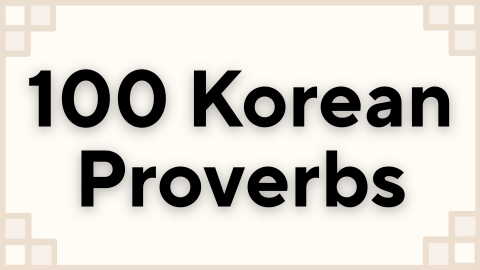Korean Lessons ᚛ Level 2 - Korean for Beginners #1 (Lessons 31 to 60) ᚛ Lesson 54 - The adjectival form for action verbs
The adjectival form for action verbs
In the previous chapter, we saw how to use the adjectival form with descriptive verbs. Now we're going to see how to use it with action verbs.
What does it mean to qualify with a verb?
As we saw in the previous course, the adjectival form can be used to qualify a noun. With Korean descriptive verbs, we get adjectives in English. But what about with action verbs?
Take the English adjective "pretty" (= 예쁘다) and the verb "to come" (= 오다). Try to express the idea of a person eating while qualifying him/her with the adjective "pretty" or the verb "to come".
"The pretty person eats."
- Since "pretty" is an adjective, it can be used as an adjective and simply placed in front of the noun.
"The person who is coming eats."
- As for "to come", it is a verb and not an adjective. Generally, to qualify a person with a verb, we use a relative pronoun like "who" or "which", among others.
The adjectival form used with action verbs will also allow us to qualify nouns with relative pronouns.
Qualify with an action verb in the present tense
In the present tense - The general rule
In the present tense, qualification with an action verb is done in the following manner:
[Stem]는
The action verb 가다 (= to go) has 가 for its stem, and we add 는 to it.
- 가다 → 가는 (= who goes / where I go)
The action verb 듣다 (= to listen) has 듣 for its stem, and we add 는 to it.
- 듣다 → 듣는 (= who listens / that I listen to)
거짓말하는 사람은 절대 용서하지 않을 거야.
→ I will never forgive people who lie.
나는 뭐든지 잘 먹는 사람을 좋아해.
→ I like people who eat everything.
도서관은 책을 빌리는 곳입니다.
→ The library is the place where you borrow books.
5월에 결혼하는 커플이 가장 많아.
→ Couples get married most often in May. (lit: In May, the couples who get married are the most numerous.)
In the present tense - The stem ends in ㄹ
For action verbs with a stem ending in ㄹ, the adjectival form is obtained in the following manner:
Drop the final ㄹ from the stem, then add 는 conforming to the rule for the construction of the adjectival form in the present tense.
The action verb 살다 (= to live) has 살, which ends in ㄹ, for its stem. First, we drop the final ㄹ of the stem, obtaining 사. Then we add 는. So, the adjectival form of 살다 is 사는.
The action verb 팔다 (= to sell) has 팔, which ends in ㄹ, for its stem. First, we drop the final ㄹfrom the stem, obtaining 파. Then we add 는. So, 팔다 has 파는 for its adjectival form.
Qualify using an action verb in the past tense
In the past tense - General rule
To qualify with an action verb in the past tense, we use the following endings:
- If the stem of the verb ends in a vowel: [Stem]ㄴ
- If the stem of the verb ends in a consonant: [Stem]은
The action verb 오다 (= to come) has 오, which ends in a vowel, for its stem. We add ㄴ to it.
- 오다 → 온 (= who has come / who had come)
The action verb 읽다 (= to read) has 읽, which ends in a consonant, for its stem. We add 은 to it.
- 읽다 → 읽은 (= which is read / which had been read / that I have read)
민지가 쓴 글입니다.
→ This is the text that Minji wrote.
언니가 준 화장품이야.
→ These are the cosmetics that my older sister gave me.
이 부분은 이미 공부한 내용이에요.
→ This part is the content I've already studied.
그건 그냥 문득 떠오른 생각이었어.
→ It was just an idea that suddenly came to my mind.
Note: You will notice that the endings for descriptive verbs in the present and for action verbs in the past are identical. Because of this, all of the exceptions in the section about descriptive verbs apply to action verbs in the past tense.
In the past tense - The stem ends in ㄹ
For action verbs with a stem ending in ㄹ, the past tense adjectival form is obtained in the following manner:
Drop the final ㄹ from the stem, then add ㄴ conforming to the rule for construction of the adjectival form in the past tense.
The action verb 만들다 (= to make) has 만들, which ends in ㄹ, for its stem. First we drop the final ㄹ from the stem, obtaining 만드. Then we add ㄴ. So, the past tense adjectival form of 만들다 is 만든.
The descriptive verb 울다 (= to cry) has 울, which ends in ㄹ, for its stem. First we drop the final ㄹ from the stem, obtaining 우. Then we add ㄴ. So, 울다 has 운 for its past tense adjectival form.
In the past tense - The stem ends in ㅂ
For action verbs with a stem ending in ㅂ, the past tense adjectival form is obtained in the following manner:
Drop the final ㅂ from the stem, then add 운.
The action verb 줍다 (= to gather) has 줍, which ends in ㅂ, for its stem. First, we drop the final ㅂ from the stem, obtaining 주. Then we add 운. So, 줍다 has the past tense adjectival form 주운.
In the past tense - The stem ends in ㄷ
For irregular action verbs with stems ending in ㄷ, the past tense adjectival form is obtained in the following way:
Replace the final ㄷ of the stem with ㄹ, then add the ending 은, conforming to the rule for the construction of the adjectival form in the past tense.
The irregular action verb 듣다 (= to hear) has 듣, which ends in ㄷ, for its stem. First we replace the final ㄷ of the stem with ㄹ, obtaining 들. Then we add 은. So, 듣다 has 들은 for its past tense adjectival form.
In the past tense - The stem ends in ㅅ
Learn more
Qualify with an action verb in the future tense
To qualify with an action verb in the future tense, we use the modifier -(으)ㄹ.
- If the stem of the verb ends in a vowel: [Stem]ㄹ
- If the stem of the verb ends in a consonant: [Stem]을
The action verb 사다 (= to buy) has 사, which ends in a vowel, for its stem. We add ㄹ to it.
- 사다 → 살 (= which will be bought / that I will buy)
The action verb 먹다 (= to eat) has 먹, which ends in a consonant, for its stem. Therefore we add 을.
- 먹다 → 먹을 (= which will be eaten / that I will eat)
여름에 갈 여행지를 정했어요.
→ I have decided on the destination for my summer vacation. (Lit: I have decided on the destination where I will go on vacation this summer.)
7시부터 운동할 시간이에요.
→ Starting at 7:00, it will be time to work out.
내가 물을 질문에 대답해.
→ Respond to the questions I'm going to ask you.
아직도 배울 게 많아.
→ I still have a lot of things to learn. (Lit: The things that I will learn are still numerous.)
Qualification and context of adjectives in Korean

Learn more
Summary table of structure
Learn more
Exercises
Learn more
You already know some vocabulary and sentence structures… But when you listen to Koreans speak, do you ever feel like something is missing, the meaning behind the words, the cultural nuance that makes the language truly come alive?
That’s completely normal. In Korean, proverbs and idiomatic expressions are essential to understanding how Koreans think and communicate. Without them, you can speak, but your language will feel flat and overly literal.
With 100 Korean Proverbs - Illustrated and Explained, you’ll understand not only what Koreans say, but why they say it, and what each expression reveals about their mindset and culture.
Learn more

